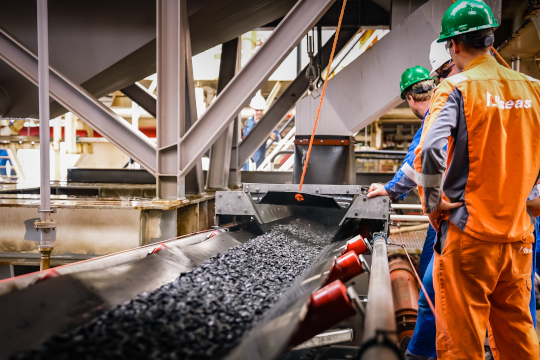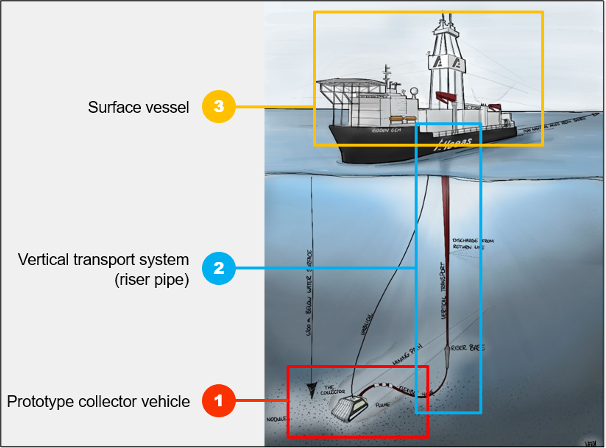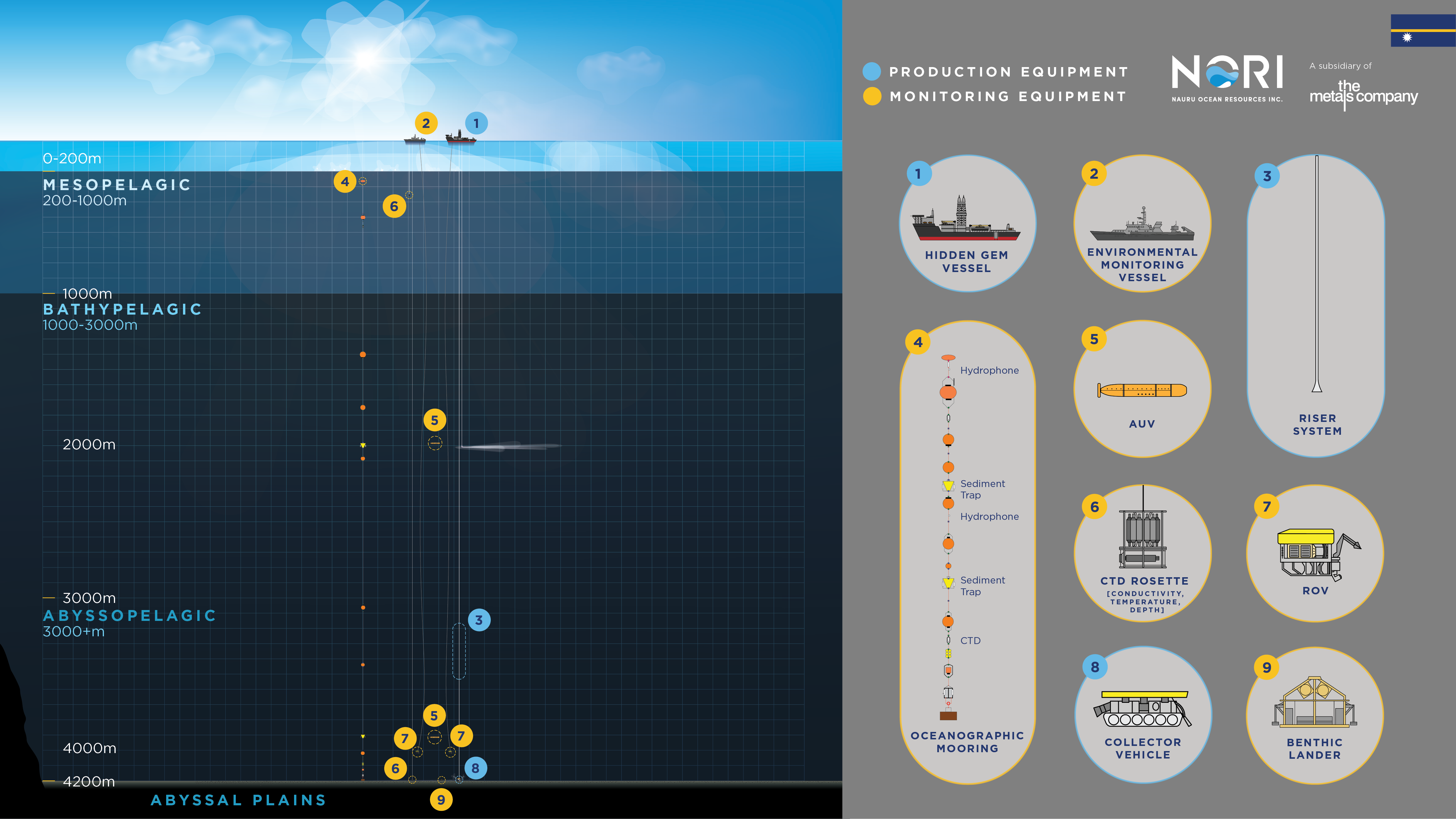Collection System Trials
In November 2022, TMC’s subsidiary NORI and offshore partner Allseas successfully concluded the first integrated collection-system test in the Clarion Clipperton Zone (CCZ) since the 1970s and achieved all significant pilot milestones. In total, the operation collected approximately 4,500 tonnes of (wet) seafloor polymetallic nodules: it transported over 3,000 tonnes (wet) up a 4.3km riser system to the surface production vessel, the Hidden Gem, while purposely leaving the additional 1,500 tonnes of nodules behind on the seafloor. Our engineering partner, Allseas, spent three years developing and constructing the prototype polymetallic nodule-collection system for the test. Furthermore, TMC submitted a dedicated offshore environmental impact statement (EIS) and environmental monitoring and management plan (EMMP) for this test. NORI distributed the EIS for stakeholder comments and revised the document based on the feedback before the ISA recommended the company could proceed with the test.
The collection test had four main objectives:
Objective #1
Demonstrate integrated pilot system capable of collecting and lifting nodules

First successful integrated pilot system test in CCZ since 1970s
Objective #2
Collect ~3,600 wet tonnes of polymetallic nodules

4,500 wet tonnes collected
3,021 wet tonnes lifted
Objective #3
Test pilot system performance to inform future system optimizations and upgrade

86.4t/h production rate
Performance data acquired to be used to upgrade and optimize pilot system into Project Zero system with a targeted average production rate over 200t/h
Objective #4
Monitor and survey pre-, during- and post- test environment

Pre- and during surveys complete
Post-test surveys complete
During the integrated collection-system test, the prototype collector vehicle travelled over 80km across the seafloor in an 8km2 section of NORI-D allocated for the test. Allseas engineers put the pilot nodule collector through various tests and achieved a sustained production rate of 86.4 tonnes per hour (roughly equivalent to transporting 40 Tesla Model S vehicles to the surface every 60 minutes).
We used a nozzle design that employs water jets to entrain nodules while minimizing the disturbance of sediment. The nozzle design reduces the benthic plume’s size and extent to which it spreads and also minimizes the mid-water plume since it reduces the amount of entrained sediment that the system transported along with the seawater and nodules to the surface. We injected compressed air into a 4.3km riser pipe approximately 2km below the surface to create a partial vacuum that lifted the nodules, seawater, and sediment onto the production vessel. In total, we lifted over 3,000 tonnes of wet nodules to the surface during the test.

Onboard the Hidden Gem, a cyclone separator slows down the flow before separating out the nodules from the water and entrained sediment. A conveyor belt then transports the nodules to the vessel’s hold for storage. The system returned the separated water, residual sediment, and fine nodule fragments to the water column at 1,200m below the surface.
During the production ramp-up sequence in October 2022, a temporary overflow that comprised seawater mixed with sediment and nodule fragments in small amounts occurred. We notified the ISA about the event, and both the ISA and independent reviewers determined it to have no potential to cause significant harm to the marine environment. Based on an assessment conducted in collaboration with subject matter experts, we made modifications to the cyclone separator, and no further overflows during subsequent test runs occurred. As we outline in the offshore EIS for the NORI-D collector test, we conducted these trials to test an untried system and to identify opportunities to optimize the design of a full-size commercial system. Based on learnings from the test, Allseas is now scaling up the collection system for an increased production capacity for NORI’s Project Zero to an estimated 3.0 million wet tonnes per annum (Mtpa), including an additional 15-meter-wide collector vehicle, a wider diameter riser pipe, larger compressor spread, and improvements to the system designed to further mitigate its environmental impacts.
We also conducted the collection test to monitor the impact that the system had on the environment during operations. Specifically, the studies that NORI executed during the system test ranged from above the ocean surface (e.g., avian fauna flying above the water) down approximately 4km through the entire pelagic water column (epi-, meso-, and abyso-) into the abyssal sediments on the seafloor. These studies focused on characterizing the potential environmental impacts associated with the operation.
Production and Monitoring Equipment Deployed During the Collection System Test

We collected near-field data (i.e., <200m from the collector system) from the Hidden Gem, whereas we collected far-field data (i.e., > 200m from the collector system) from a 103m research vessel—one among only a handful in the world with the equipment that one needs to perform autonomous underwater vehicle (AUV) surveys, multibeam seabed surveys, and remotely operated vehicles (ROV) surveys at depths greater than 4km.
We conducted the system test and environmental monitoring in three steps:
- We conducted the first aboard a research vessel where scientists gathered critical data to help develop a pre-disturbance environment baseline. We deployed multiple subsea assets at the seafloor and throughout the mid-water column to characterize the ecosystem baseline prior to disturbance.
- The Hidden Gem then joined the research vessel at NORI-D. We deployed the collection system and put it through its paces to test its overall performance and how efficiently it picked up and transported nodules. Simultaneously, independent scientists measured the system’s environmental performance by monitoring the benthic and mid-water plumes’ density, their physical and chemical composition, the extent to which they spread, and the noise that the system generated.
- We conducted the third step aboard the research vessel after we completed the successful collection system test and the Hidden Gem departed the area. Scientists repeated all the workstreams from the initial baseline studies to assess the state of the ecosystem after the disturbance. They took low-altitude camera images with an AUV to compare the seabed topography and faunal communities before and after disturbance. They also took box core and multicore samples from the disturbed areas to compare if and how the epifauna, infauna communities, and sediment geochemistry may have changed due to the disturbance. Finally, the scientists visually assessed sedimentation plates to determine the extent to which sedimentation spread from the point of disturbance.
In 2023, we revisited the site to assess the impact one year after the collection system test. Marine scientists conducted an array of studies to collect further environmental data on ecosystem functioning in the area of the pilot nodule collection system test as well as in areas adjacent to and at various distances from the collector tracks. Independent world-leading deep-sea research institutions have contributed to the environmental baseline and impact studies that will form the basis of the NORI-D offshore environmental impact assessment (EIA) in our application for an exploitation contract, which we plan to submit after the ISA Council meeting of July 2024. We expect these institutions to continue to openly publish their research in peer-reviewed journals.
Collaborating with Leading Research Institutions and Industry Experts to Understand Our Offshore Environmental Impacts

